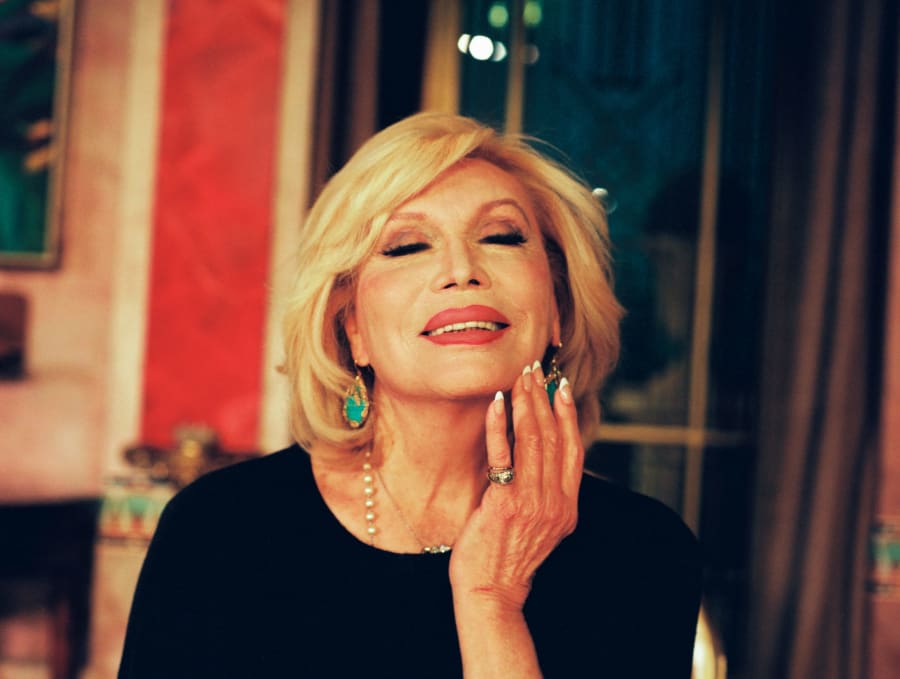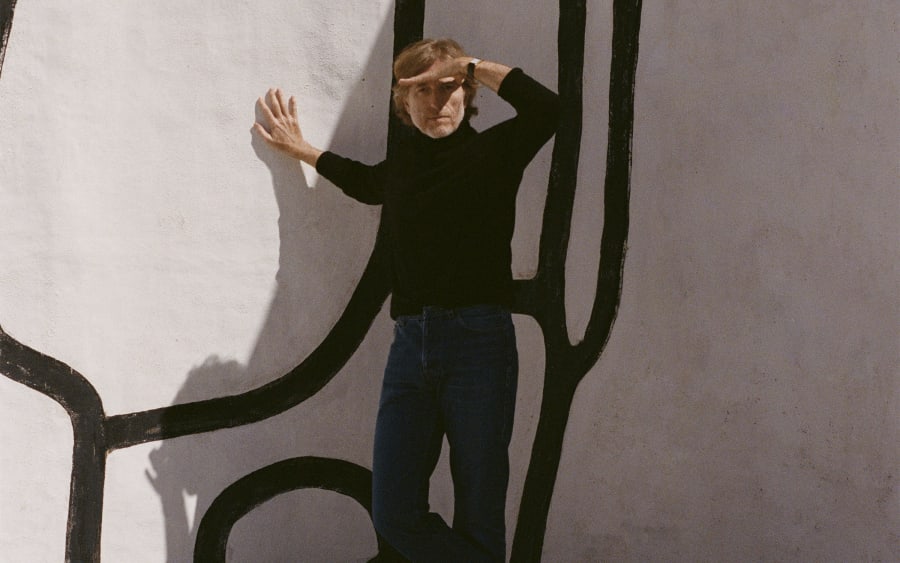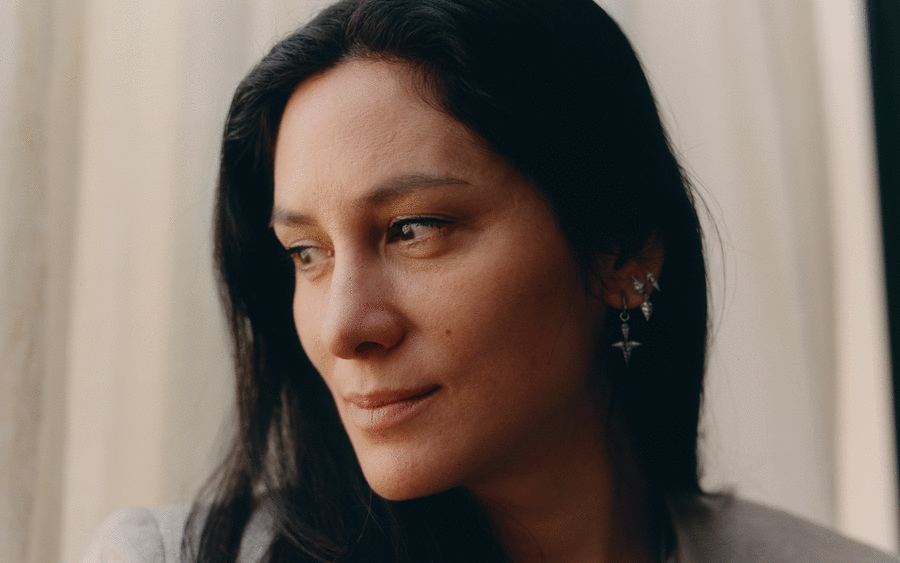agnès b. is one of the most important French designers of her generation – and one of the most significant patrons to have emerged in France in recent decades. In 1979, she created the snap button cardigan, which crystallized the image of the casual-chic French woman. Now 82, agnès b., looks as sparkling as ever. From the outset she has been committed to the environment and numerous social causes, and curious about everything, her interests extend to an art gallery, museum exhibitions, a magazine, a bookshop, and a radio station. She finances her many cultural projects through her eponymous clothing brand. Today, her company CMC has 286 points of sale, including 58 retail outlets, with sales totalling 40 million euros in 2021.
agnès b is also an avid collector of contemporary art. We caught up with the designer for tea in Kensington Gardens in London, before she headed off to see her friends Gilbert & George.
Agnès Troublé, known as agnès b., easily opens up on her childhood in Versailles, in a strict, bourgeois home just 150 meters from the famous palace designed by Louis XIV. She spent much of her free time in the rooms and gardens there, scrutinizing the works of art. Early on, her father noticed her passion for culture and took her to Florence, to see the great Italian masters. ‘I saw my first Botticelli at the age of 12,’ she enthuses. During one of her visits, she expressed the wish to become a museum curator or gallery owner. ‘I wrote down my dream on a sheet of paper, which I kept like an oracle, so that it would come true.’ Between the ages of 12 and 17, agnès b. took drawing classes at the École des Beaux-Arts in Versailles. Observing masterpieces slowly led her to photography, and using an old Nikon camera, she captured her subjects in great detail. For agnès b., beauty is just as easily found in a painting by the Baroque artist Charles Le Brun as it is in the magnolia blossoming outside her window.
After working for Elle magazine, and the labels Dorothée bis and Cacharel, agnès b. opened her first boutique on rue du Jour in 1976, in a former butcher’s shop. In 1984, she inaugurated the galerie du jour with Jean-René de Fleurieu. They showed the work of many artists influenced by urban space, such as Roman Cieslewicz, Katsuhiko Hibino, Futura 2000, and photographers still little known in France at the time, such as Nan Goldin.
She collects works of art with passion, just like she prints artworks on T-shirts – something she’s done regularly since in her first collaboration in 1978 with Loulou Picasso and Dominique Fury. In 1994, prompted by Felix Gonzalez-Torres, she formalized her series of artists’ T-shirts. ‘Nobody Owns Me’ proclaimed Gonzalez-Torres’s cotton top. This was followed by collaborations with Seydou Keïta, Rafael Gray, and Louise Bourgeois... The aim was always to share an artistic vision with as many people as possible.
Unaffected by trends, agnès b. relies on instinct when it comes to art. This is why she is as attached to the artists themselves as she is to their work. With Jean-Michel Basquiat, it was love at first sight. ‘I had seen his work at the Paris Biennale in 1983, without knowing anything about him. His painting jumped out at me,’ she explains. ‘I then asked my New York gallerist friend, Philippe Briet, to go to his studio and bring me back a work.’ The drawing is still part of her collection, and has been joined by a few others amassed over the years. ‘I don’t resell anything, and I don’t buy art thinking I’m making a financial investment. Collecting is a matter of emotion and pleasure.’
She met Basquiat a few years later, in 1987, at an opening at Yvon Lambert in Paris. ‘Jean-Michel knew my work because Andy Warhol had bought him some shirts in our brand-new boutique in Soho. We talked about art and Versailles, which he knew by heart!’ recalls the designer. After a dinner at Jean-Charles de Castelbajac’s – which she didn’t attend – the young Basquiat called her at 4 am, and she confesses with a smile, asked her to join him. While she modestly leaves the story hanging, we understand that behind each work in the collection lies a personal story.
With Gilbert & George, the connection has more to do with politics: ‘I like them a lot because they’re committed and aren’t afraid to put across anti-establishment, very left-wing messages.’ In 1997, agnès b. made a small publication to accompany their exhibition at the Musée d’art moderne de la ville de Paris. ‘Artists aren’t necessarily political spokespeople, but they can play an important role, because they point out things that aren’t right,’ the designer explains. The designer’s stance is partly explained by the abuse she suffered in her youth – a trauma which would mark her for life. In 2013, the designer tackled incest in the film Je m’appelle Hmmm..., which she signed with her real name to reveal publicly that she was molested by her uncle during her adolescence. Her choice to surround herself throughout her life with people who have learned to confront their fears and anger through art, and who express with means beyond words their concerns and their unspeakable inner distress, is perhaps clearer in the wake of this film.
Over the years, agnès b. has taken on a host of projects. Point D’Ironie magazine, launched with Christian Boltanski and Hans Ulrich Obrist in 1997, is a hybrid periodical that gives artists carte blanche. The first issue was designed by Jonas Mekas and launched during the Cannes Film Festival. The publication, which is free of charge, still exists and has a print run of over 100,000 copies. Recent guests have included Jim Jarmusch, Futura 2000, and Rirkrit Tiravanija.
Her collection circulates thanks to numerous museum collaborations, such as loans to the Centre National de la Photographie in Paris in 2000, a major retrospective organized by Les Abattoirs in Toulouse in 2004, and an exhibition of photographs at C/O Berlin in 2008. In 2009, agnès b. set up an endowment fund – enabled by a French law on the modernization of the economy – with the purpose of preserving and presenting her collection to the general public. She then showed part of her collection at LaM in Lille, France (2015), at Museum EKi Kyoto, Japan (2017), and at the École nationale supérieure de la photographie in Arles, France (2019).
Although she is surrounded by a solid team, agnès b. decides on all of her purchases independently. This has been the case since she acquired her first work in 1963 – a self-portrait by Antonio Recalcati (although the work was technically gifted by the artist). She buys ‘by feel,’ she says, without really looking at price. Her generous annual budget and her interest in young, generally affordable art leave her relatively free. Acquisitions are made in galleries, in artists’ studios, or sometimes online, after leafing through the catalog of a small auction house, ‘but not at Christie’s or Sotheby’s’ she jokes, ‘it’s too expensive!’
In 2020, agnès b. brought together all her artistic projects under one roof, in a complex located in the heart of Paris’s 13th arrondissement. Comprising nine social housing units designed by SOA Architectes, La Fab. spans 1,400m2. It includes a bookshop, the galerie du jour, and a huge space for temporary and thematic exhibitions organized around the 5000-piece collection.
Until October 27, 2024, galerie du jour is exhibiting ‘Contemporary Figurative Painting’, featuring works by Claire Tabouret and Pascale Marthine Tayou, as well as two paintings by Harmony Korine, purchased a few months ago from Hauser & Wirth. The multi-disciplinary artist, who has worked with the likes of Larry Clark and Björk, lived for two years in a studio above agnès b.’s apartment.
Attempting to list the designer’s many artistic endeavors may seem arduous, but while the forms are manifold, the substance is always the same. She practices a philanthropy that comes from the heart, that reaches out first and foremost to sustain artists. Its origins are deeply rooted in an unshakeable Christian faith. ‘It may sound simplistic, but I adopt the policy of “love one another” – that’s what drives life,” explains agnès b. She is patron of La Fondation Abbé Pierre, named after a priest who dedicated his life to helping the homeless and who died in 2007. In collaboration with the graffiti artist JonOne, she has produced a T-shirt featuring Abbé Pierre, with all proceeds going to the foundation. An eternal optimist, agnès b draws her life lessons from the Bible. Her goal is to support artists, and give them an important platform to use their voices for the good of humanity.
Maïa Morgensztern is an art and culture journalist and radio presenter based in London. She studied Art History at the Sorbonne, Paris, and at the Smithsonian Institution, Washington DC.
Caption for header image: agnès b. in front of La Fab. Courtesy of agnès b.
Published on June 20, 2024.


